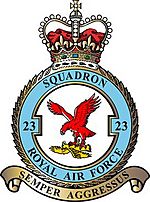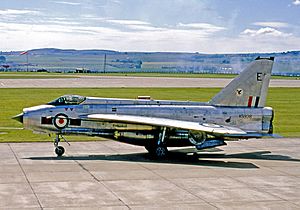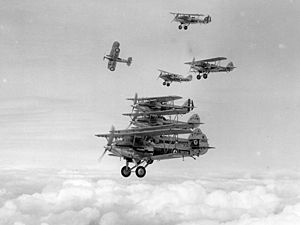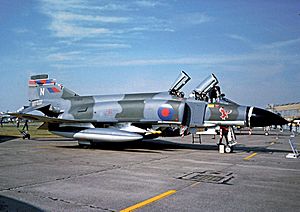No. 23 Squadron RAF facts for kids
Quick facts for kids No. 23 Squadron RAF |
|
|---|---|

No. 23 Squadron badge
|
|
| Active | 1 September 1915 – 1 April 1918 (RFC) 1 April 1918 – 31 December 1919 (RAF) 1 July 1925 – 25 September 1945 1 September 1946 – 31 October 1975 1 November 1975 – 31 October 1988 1 November 1988 – 2 October 2009 January 2021 – Present |
| Country | |
| Branch | |
| Motto(s) | Latin: Semper Aggressus ("Always on the attack") |
| Battle honours |
|
| Insignia | |
| Squadron badge | An eagle preying on a falcon. Approved by King George VI in April 1937. |
| Squadron roundel |  |
| Squadron Codes | MS Sep 1938 – Sep 1939 YP (Sep 1939 – May 1945;Sep 1946 – Apr 1951) EA–EZ (Nov 1988–Feb 1994) |
No. 23 Squadron is a special part of the Royal Air Force (RAF). It was recently restarted in 2021 as the RAF's very first "space squadron." This means they handle daily operations related to space. Before this, the squadron used to fly large Sentry AEW1 planes. These planes were like flying control centers, helping to watch the skies. They flew from RAF Waddington in Lincolnshire.
Contents
The History of No. 23 Squadron
No. 23 Squadron has a long and exciting history. It has flown many different types of aircraft and played important roles in major conflicts.
Flying in World War I
No. 23 Squadron first started on 1 September 1915. Back then, it was part of the Royal Flying Corps, which was the air force before the RAF. They were based at Fort Grange in Gosport. At first, they used different kinds of planes. Some of their planes, called B.E.2cs, were sent to Sutton's Farm. Their job was to act as night fighters against German Zeppelin airships. However, they didn't manage to shoot any down.
The squadron moved to France on 16 March 1916. There, they flew FE2b planes. These were two-seater "pusher" fighters, meaning the propeller was at the back. The squadron used these planes to escort other aircraft and patrol the skies. They helped the Allies gain control of the air before the big Battle of the Somme.
By late 1916, the FE2b was getting old. So, in February 1917, the squadron started getting new Spad S.VII single-seat fighters. They used these fast planes for offensive patrols over the front lines. They also flew low to attack German troops on the ground. In December 1917, they upgraded to the more powerful Spad S.XIII. In April 1918, they switched to Sopwith Dolphins. The squadron was disbanded on 31 December 1919, soon after the war ended. During World War I, 19 flying aces were part of No. 23 Squadron.
Reforming and New Planes
No. 23 Squadron was started again on 1 July 1925. They were based at RAF Henlow and flew Sopwith Snipe planes. The famous World War I pilot Raymond Collishaw was in charge. In May 1926, they got more modern Gloster Gamecock fighters. They then moved to RAF Kenley in February 1927.
In April 1931, the squadron began to use Bristol Bulldogs, another type of single-seat fighter. They also kept flying the Gamecocks. At this time, a new bomber plane, the Hawker Hart, was faster than their fighters. So, in June 1931, the squadron got a special Hart plane to test as a two-seat fighter. This test was successful! By October, they started replacing their Gamecocks with fighter versions of the Hart, called Hart Fighters.
The squadron moved to RAF Biggin Hill in September 1932. By April 1933, they were fully equipped with these Hart fighters, which were now known as Hawker Demons. In September 1935, during the Abyssinia Crisis, the squadron had to give up many of its planes and pilots to help other squadrons overseas. Their strength dropped a lot, but they soon got back to full power. They moved to RAF Northolt in December 1936, and then to RAF Wittering in May 1938. In December 1938, they replaced their older Demon biplanes with the Bristol Blenheim. This was a twin-engine monoplane, which was a bomber converted into a fighter.
No. 23 Squadron in World War II
When Second World War started, the squadron was still flying Blenheims. Their new job was to be a night-fighter squadron. They got their first victory on 18 June 1940. They shot down a German Heinkel He 111 over Cley next the Sea. Another He 111 was shot down that same night. However, two of their own Blenheims were lost.
The Blenheim was too slow for night fighting. So, in December 1940, the squadron started a new role called "night intruder." This meant they would attack German bombers as they returned to their airfields in France. From March 1941, they replaced their Blenheims with American Douglas Havoc planes. In February 1942, they also got the Boston III version of the Havoc.
In July 1942, the squadron received the much better de Havilland Mosquito aircraft. In December 1942, they moved to the Mediterranean region. They flew from RAF Luqa on the island of Malta. From there, they attacked enemy airfields and railway targets in Sicily, Tunisia, and Italy throughout 1943. In December 1943, they moved to Sardinia. This allowed them to attack targets in Southern France.
In June 1944, the squadron returned to England. They operated from RAF Little Snoring in Norfolk. They were part of 100 Group, which supported bomber planes. No. 23 Squadron's job was to fly low-level night intruder missions. They aimed to stop German night fighters from attacking British bombers. Besides night missions, they also flew daylight bomber escort missions. After the war ended, No. 23 Squadron was disbanded on 25 September 1945.
After the Wars: Jet Age and Air Defence

The squadron was reformed on 1 September 1946 as a night fighter squadron. They flew de Havilland Mosquito planes again. In 1953, they got their first jet aircraft, the de Havilland Vampire NF.10. They replaced these with de Havilland Venom NF.2s in June 1954, and then Venom NF.3s in 1957.
In 1957, the squadron switched to the Gloster Javelin. This was an all-weather fighter plane. This began a long time where the squadron focused on air defence. They have a strong history in protecting the skies. They operated Gloster Javelins, Lightnings, Phantoms, and Tornado F3s.
The squadron first got Phantoms on 1 November 1975 at RAF Coningsby. They then moved to RAF Wattisham for almost 10 years. In October 1983, the squadron went to Stanley airfield in the Falkland Islands. They arrived there on 1 November, after the islands were taken back from Argentina. They stayed there until 31 October 1988. Then, another unit, 1435 Flight, took over their duties.
No. 23 Squadron reformed again on 1 November 1988 at RAF Leeming. They flew the Panavia Tornado until 26 February 1994, when the unit was disbanded once more.
The squadron took on the role of Airborne Early Warning in April 1996. They shared the RAF's Sentry AEW1 planes with No. 8 Squadron. The squadron was disbanded on 2 October 2009. At that time, it joined with No. 8 Squadron.
The Future: A Space Squadron
At a special conference on 17 July 2019, it was announced that No. 23 Squadron would reform. It would become the RAF's first squadron dedicated to space. In early January 2021, the squadron officially restarted as a "space squadron." Their job is to handle the daily "command and control" of space operations. This is a very important and modern role for the RAF!
Famous People of No. 23 Squadron
Many brave and skilled pilots have been part of No. 23 Squadron.
- Douglas Bader was a member of 23 Squadron. He had a plane crash while doing low-level aerobatics and lost his legs. Despite this, he became one of the most successful flying aces for the RAF in World War II.
- Sir Peter Wykeham was an Air Officer Commanding. He was known for shooting down at least 15 enemy aircraft during World War II. He later became a very high-ranking officer, an Air Marshal.
- Andrew George Walton flew with the squadron in both Tornados and Phantoms. He rose to the rank of Air Vice Marshal and received a special award, the CBE.
- Wing Commander A J 'Red' Owen was the commanding officer of 23 Squadron from 1962 to 1964. He was one of the RAF's best night fighter pilots in World War II. He was credited with destroying at least 15 enemy aircraft.
- Air Commodore Charles Kingsford Smith was a famous Australian aviation pioneer. He joined the squadron in July 1917. While with the squadron, he shot down four German fighters. He later took on a training role within the squadron.
Aircraft Flown by No. 23 Squadron
- Bleriot XI
- Caudron G.III
- Farman Shorthorn
- Avro 504
- Martinsyde S1
- BE2c
- FE2b
- Martinsyde G.100
- SPAD S.VII
- SPAD S.XIII
- Sopwith Dolphin
- Sopwith Snipe
- Gloster Gamecock
- Bristol Bulldog
- Hawker Hart
- Hawker Demon
- Bristol Blenheim
- Douglas Havoc I
- Douglas Boston III
- De Havilland Mosquito
- De Havilland Vampire NF.10
- De Havilland Venom
- Gloster Javelin
- English Electric Lightning
- McDonnell-Douglas Phantom FGR2
- Panavia Tornado F3
- Boeing Sentry AEW1
Images for kids
See also
- List of Royal Air Force aircraft squadrons






